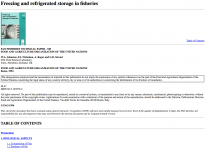Cold Storage
The use of "cold" handling and storage systems as an investment to prevent perishable food loss and waste (FLW) is widely used in developed countries. It can be highly cost effective compared to continually increasing production to meet increasing demands for these foods.
The primary segments of an integrated cold chain include:
- Packing and cooling fresh food products
- Food processing (i.e. freezing of certain processed foods
- Cold storage (short or long term warehousing of chilled or frozen foods)
- Distribution (cold transport and temporary warehousing under temperature controlled conditions)
- Marketing (refrigerated or freezer storage and displays at wholesale markets, retail markets and food service operations).
Cold storage is used to store a variety of already frozen fish and fish products and is a key component of wholesale, processed, export and retail value chain activities in many countries.
Practical Storage Lives of Fish Products
Practical Storage Lives of Fish Products
Below is an overview of expected storage times for different products at typical cold store temperatures.
Product | Storage life in months | ||
| - 18°C | - 24°C | - 30°C |
Fatty fish (glazed) | 5 | 9 | > 12 |
Lean fish (fillet) | 9 | 12 | 24 |
Flatfish | 10 | 18 | > 24 |
Shrimp (cooked/peeled) | 5 | 9 | 12 |
Quality Deterioration is the Main Cause of FLW
Quality Deterioration is the Main Cause of FLW
Quality deterioration of products during cold storage is the main cause of FLW. If quality deterioration is severe, then products maybe discarded, which constitutes a food waste.
Temperature change, biochemical changes, and dehydration during cold storage are the main causes of quality deterioration. Temperature fluctuations during storage will cause frozen products to melt or thaw slightly and then refreeze. This leads to the formation of large ice crystals inside the fish, which can cause physical damage to fish muscle.
Fish proteins become permanently changed during freezing and cold storage and the speed at which denaturation, or breakdown of protein, occurs depends largely upon temperature. Ensuring that cold storage is at as low a temperature as possible/practical slows the rate of quality deterioration due to protein denaturation.
Fatty fish may become unpleasantly altered during cold storage due to oxidation of fats, but they can be protected to some extent either by glazing or by packaging in plastic bags sealed under vacuum. These oxidation changes take place more rapidly at higher temperatures and when the product is exposed to air. Storage at a low temperature is an effective means of slowing the rate of spoilage.
The quality of fish is often judged by appearance, and color changes which are not otherwise significant can result in fish being downgraded. The changes in the fish flesh which bring about these color changes are also retarded at lower cold store temperatures.
Dehydration Concerns
Dehydration Concerns
Dehydration is a major concern. When fish get badly dehydrated in cold storage, the surface becomes dry, opaque and spongy. Visible effects of severe dehydration on the surface of the fish are known by the term "freezer burn" which usually only appears after periods of cold storage.
Frozen fish may dry slowly in cold storage even under good operating conditions. This is undesirable for reasons other than the obvious one that the product will lose weight. Drying also accelerates denaturation of the protein and oxidation of the fat in the fish. Even totally impervious wrappers used to protect the product do not give full protection if the cold store operating conditions are favorable for desiccation within the pack.
In-pack desiccation prevails when there is some free space within the wrapper/packaging and the temperature of the store fluctuates. When this occurs, there will be times when the wrapper/packaging is colder than the fish and moisture will then leave the product and appear as frost on the inner surface of the wrapper/packaging. The total weight of the product and package will not change but if the in-pack dehydration is severe, the fish will have the quality defects of excessive drying.
Key Publications
Freezing and refrigerated storage in fisheries This FAO publication provides an introduction to the operations and equipment used in fish freezing and cold storage on shore and sea, and gives information on applying low temperatures to reduce deterioration of quality. | |
|
This document describes changes that can occur in cold storage, effects of time and temperature on protein, factors limiting storage life, and emphasizes the need to store frozen fish and products at -30°C. | |
Developing the cold chain in the agrifood sector in sub-Saharan Africa Policy brief based on the proceedings of a Regional workshop on the use of the cold chain in the development of agriculture and agro industries in sub-Saharan Africa. |
More Resources
More Resources
27 February 2024
31 October 2023
05 September 2023














